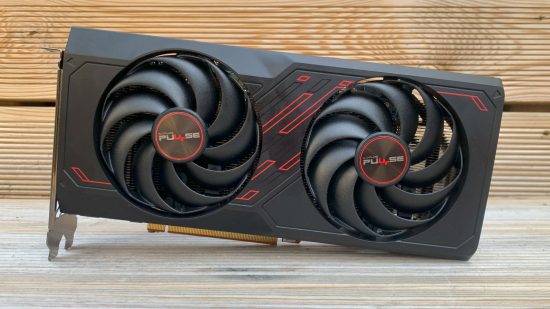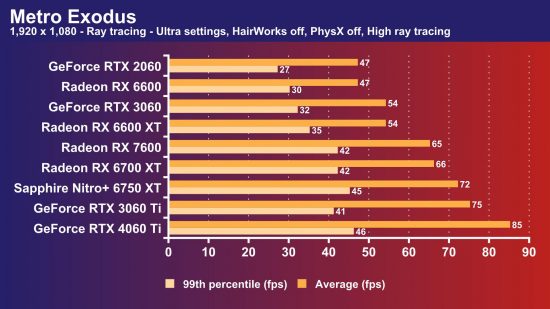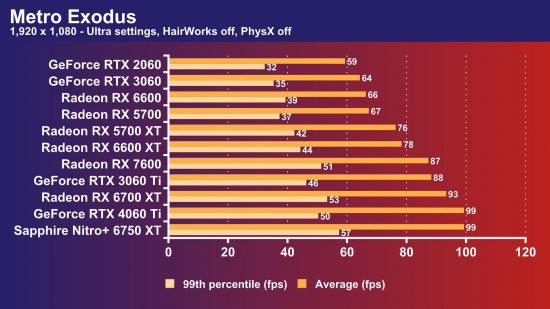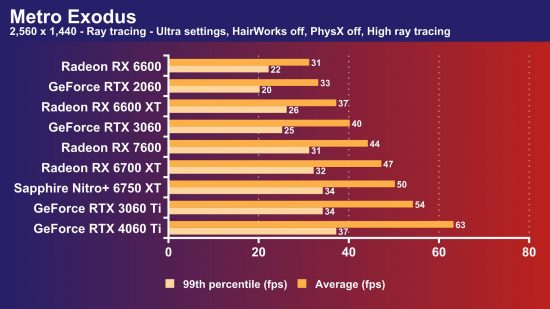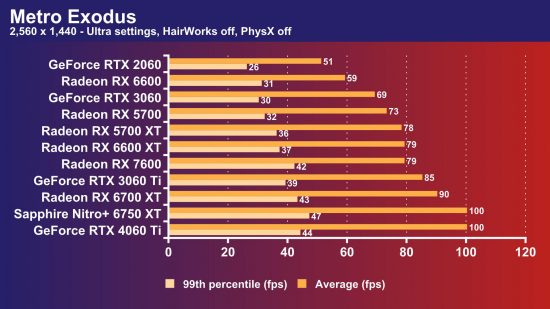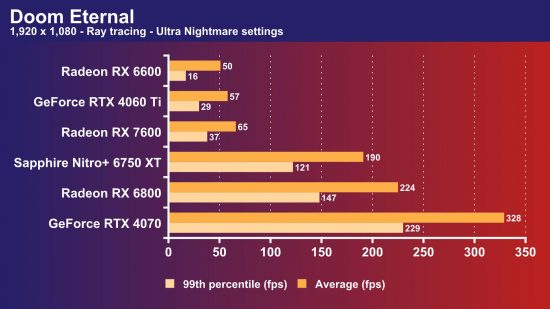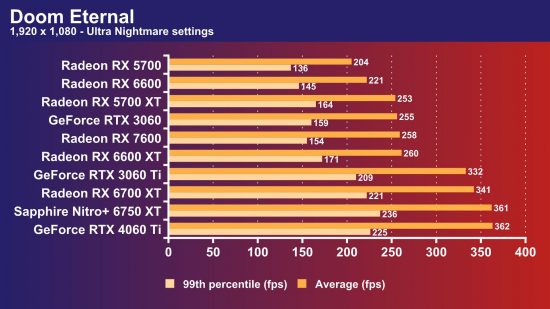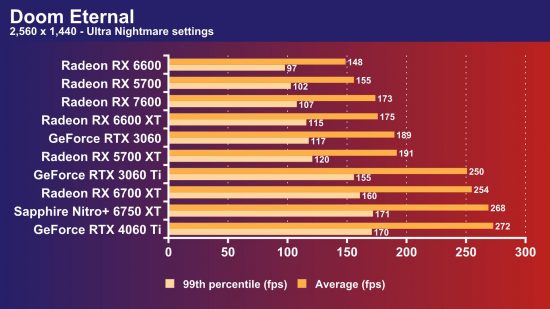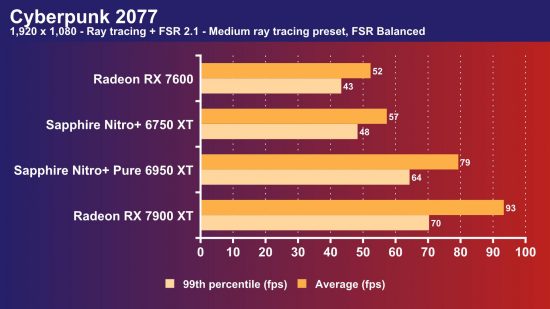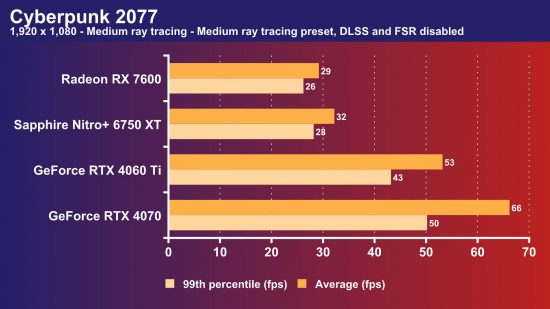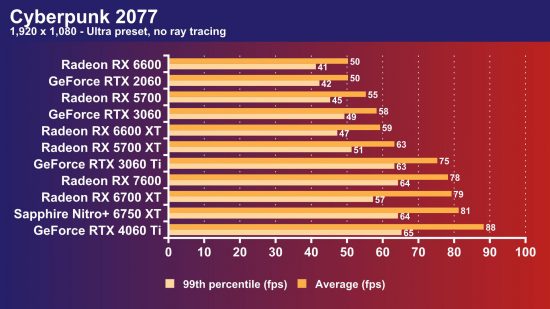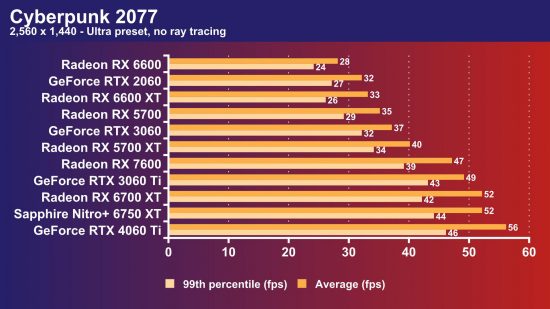Our Verdict
84%Solid 1,920 x 1,080 gaming performance for a fantastic price. You no longer need a small fortune to buy a half-decent graphics card. Thank you, AMD.
Thank you, AMD. Thank you. After years of sky-high graphics card prices, you’ve finally given us a properly affordable gaming GPU. We were expecting the price of the AMD Radeon RX 7600 to be over $300, but the fact it’s come in at just $269 (£259) is remarkable in these times.
This is a price from the time of the GeForce GTX 1060 era, when mere mortals could afford a graphics card upgrade, and we’re very glad to see it return. Here’s hoping the possibly upcoming Nvidia RTX 4050 follows this trend. The AMD Radeon RX 7600 comes just a day after Nvidia launched its underwhelming contender for the sub-$400 market – you can find out more about it in our full Nvidia GeForce RTX 4060 Ti review.
At Custom PC, we’ve been reviewing the latest gaming GPUs since 2003, and we run a number of grueling GPU benchmarks in order to gauge performance. Our game tests include measuring the frame rate in Cyberpunk 2077, Doom Eternal, and Metro Exodus, all with and without ray tracing, and we also test with Assassin’s Creed Valhalla. For more information, see our How we test page.
The AMD Radeon RX 7600 is based on the same Navi 33 chip found in some of the company’s recent mobile GPUs, such as the Radeon RX 7600M. It’s manufactured on a 6nm process and has a die area of 204mm². That’s just a little smaller than the 7nm Navi 23 GPU used in the AMD Radeon RX 6600 XT, which has a die area of 237mm².
So far, GPUs based on the new AMD RDNA 3 architecture such as the AMD Radeon RX 7900 XTX have impressed us in some areas, with strong rasterization performance for the money. However, they lag behind the latest GPUs based on the Nvidia Ada architecture when it comes to ray tracing, and while there’s reportedly AMD AI frame generation tech in the works, there’s currently no way for AMD GPUs to boost frame rates in the same way as Nvidia GPUs can with DLSS 3.
That said, with no Ada competition from Nvidia in this price bracket at the moment, AMD has this market sector all to itself. Plus, given that the AMD Radeon RX 6600 XT is our current favorite budget gaming GPU on our best graphics card guide, if the Radeon RX 7600 can beat this GPU and cost less money then it’s onto a winner.
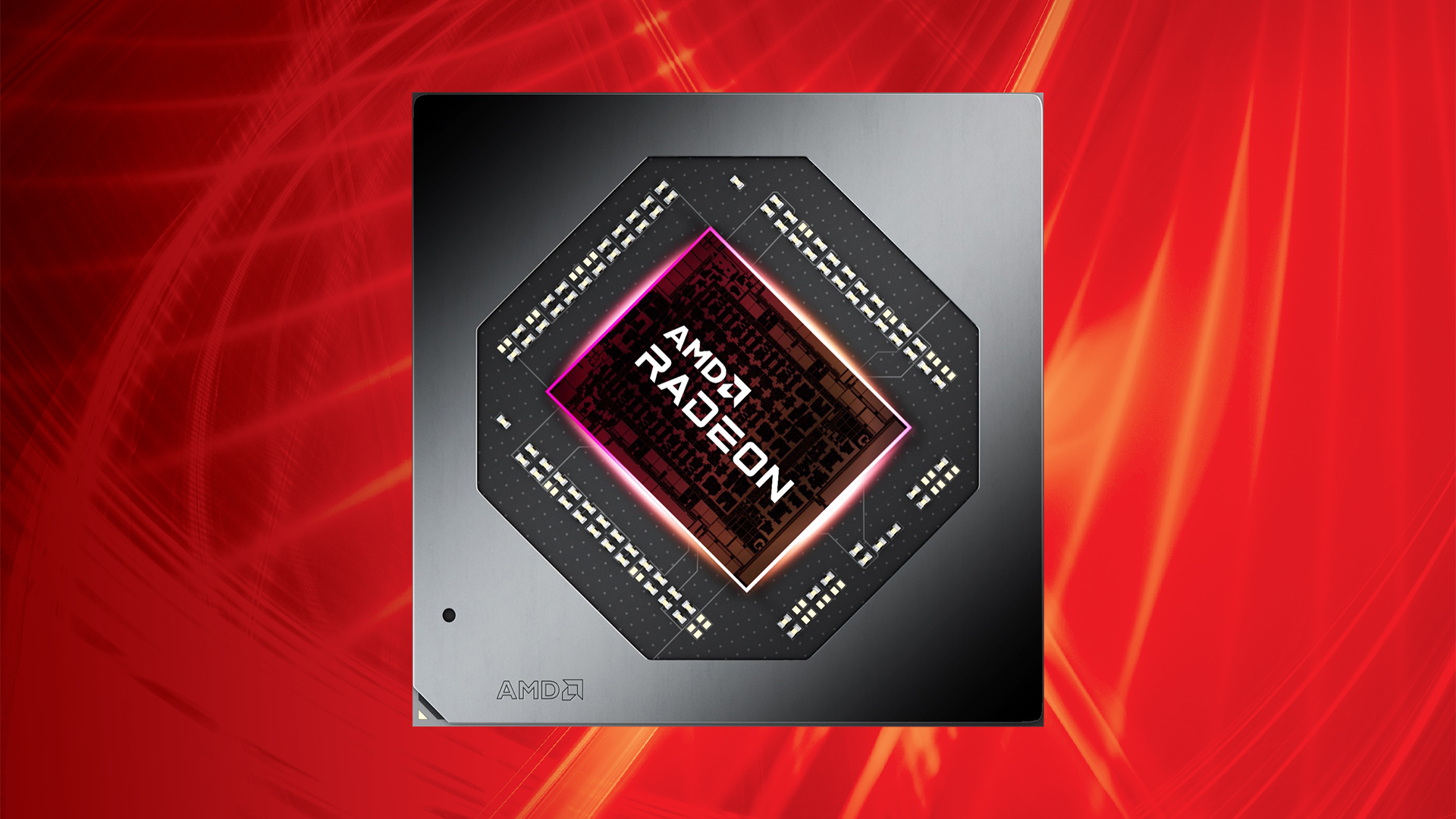
AMD Radeon RX 7600 GPU
Just like the Radeon RX 6600 XT before it, the Radeon RX 7600 has a fully-enabled chip with 32 compute units, and each of these units has an RT core for ray tracing and 64 stream processors, giving you a total of 2,048 stream processors.
It’s interesting that there’s no ‘XT’ branding on this GPU, though – the Radeon RX 6600 only had 28 compute units enabled, and cost $329 at launch. You’re basically getting the RDNA 3 equivalent of the Radeon RX 6600 XT for a much cheaper price.
The Radeon RX 7600 is also backed up with 8GB of GDDR6 memory running at 2250 MHz (18 GHz effective), which is a bump up from the 2000 MHz (16 GHz effective) GDDR6 memory found on Radeon RX 6600 XT cards.
As we found in our GeForce RTX 4060 Ti testing, 8GB is not enough memory for some circumstances now, but it’s an acceptable compromise on a card that only costs $269. AMD is targeting this card firmly at 1,920 x 1,080 gamers, and 8GB of VRAM is enough for that in most circumstances.
Like the RTX 4060 Ti, the Radeon RX 7600’s memory is also attached to a comparatively narrow 128-bit interface, and AMD is hoping to relieve the strain on the bus by equipping the Radeon RX 7600 with a large 32 MB pool of L3 Infinity Cache.
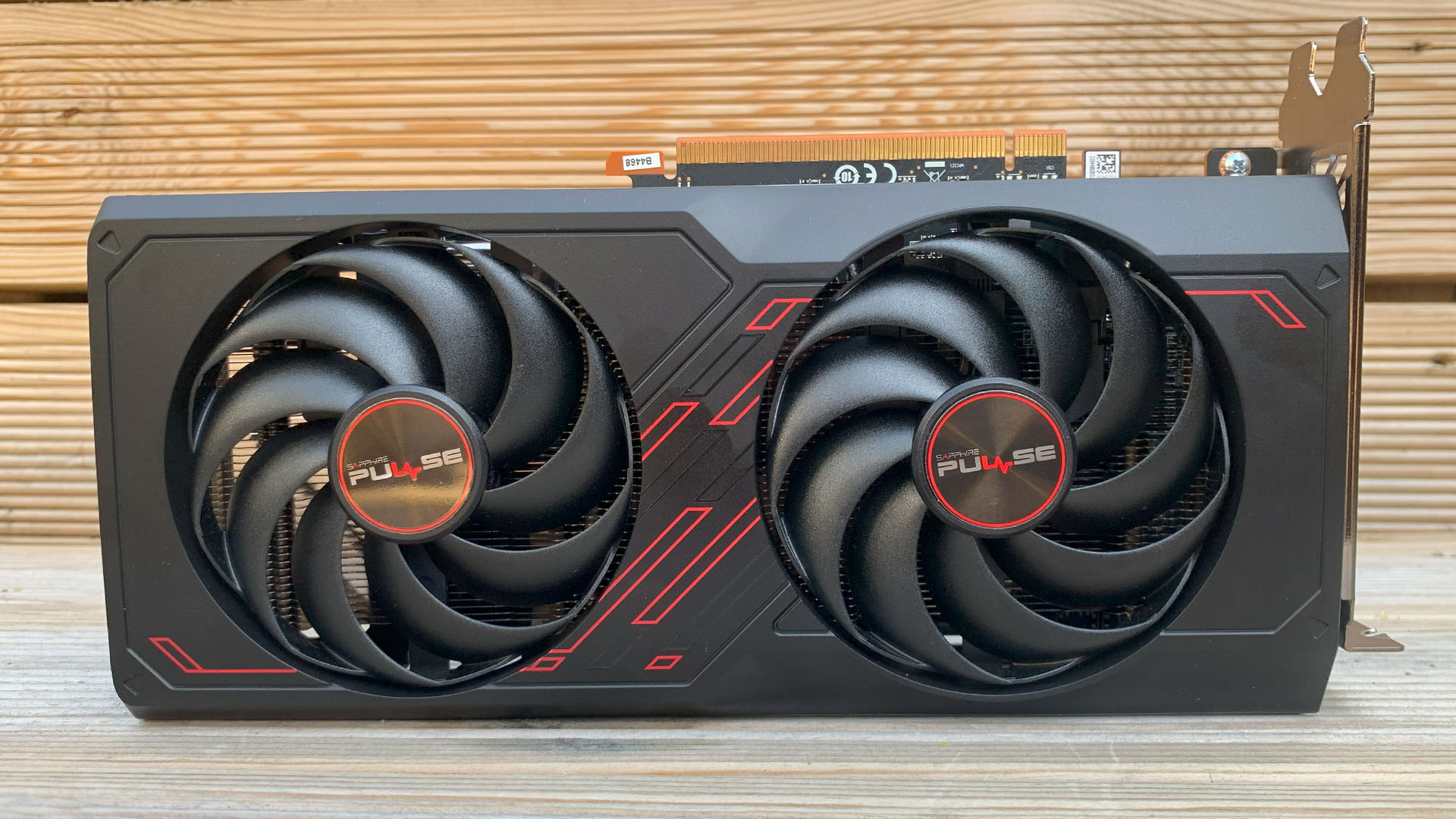
The Sapphire Pulse AMD Radeon RX 7600 card
Sapphire supplied us with one of its Pulse cards for this review, and it’s a great example of a simple design done well. There are no fancy frills on the Sapphire Pulse AMD Radeon RX 7600, such as RGB lighting, but it’s a smart, light, and compact card that will fit into many cases without sagging, and its two ball-bearing fans were quiet throughout testing as well.
There’s a relatively thin metal backplate on the rear of the card, but this never became overly hot to the touch during testing, and we didn’t observe any throttling either. Unlike a lot of Nvidia Ada cards, you also get a single 8-pin PCIe power connector on this card, so you can plug it straight into a normal PSU cable without having to faff around with adaptors.
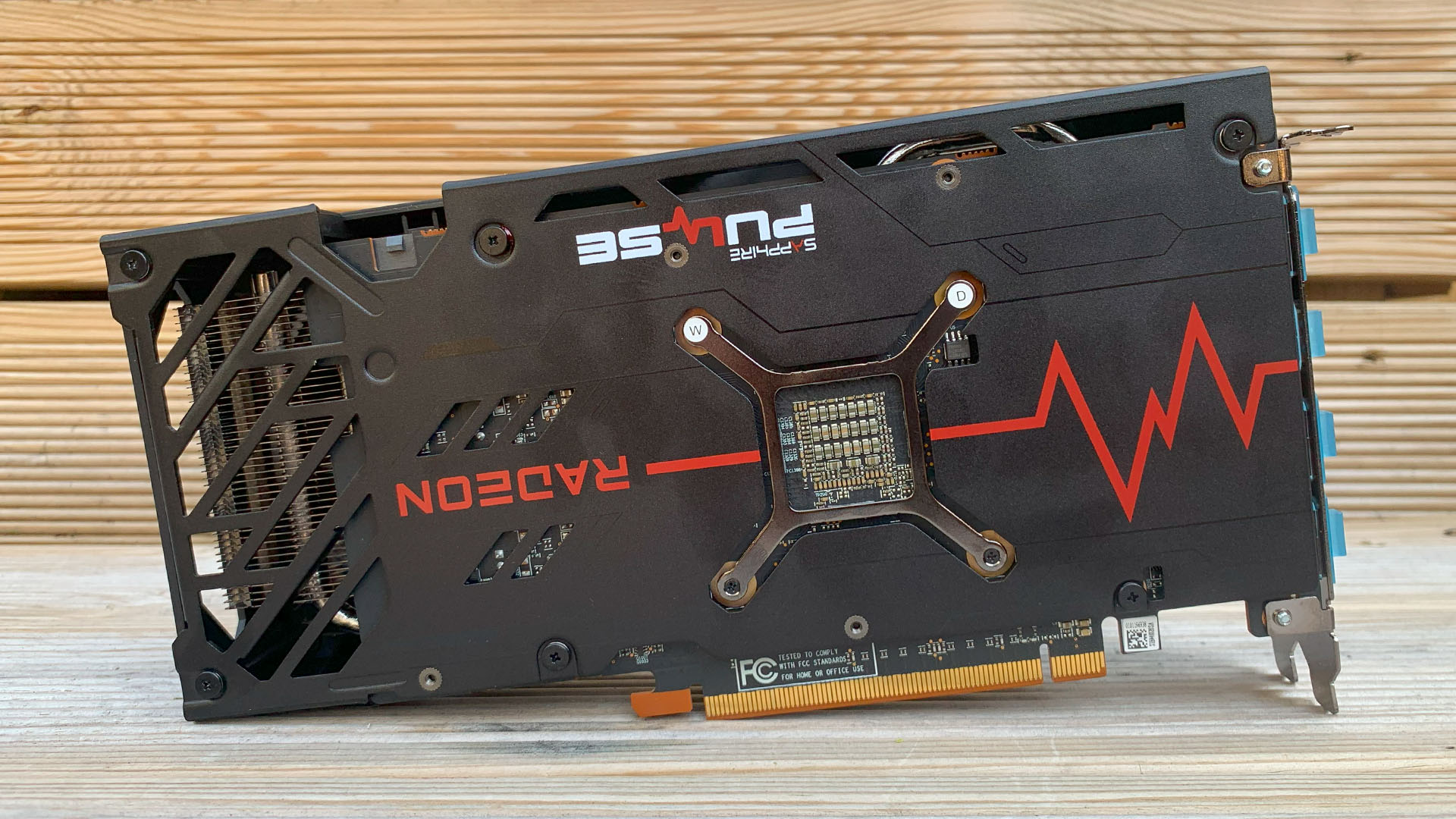
Remarkably, despite costing just $269, this card also comes with an overclock that boosts the game clock from the stock speed of 2250 MHz to 2355 MHz, and the boost clock from 2660 MHz to 2755 MHz.
As such, you can expect stock speed Radeon RX 7600 cards to run a little slower than the benchmarks we’ve listed below, but you may as well pick up this overclocked Sapphire Pulse card for this price if it’s in stock.
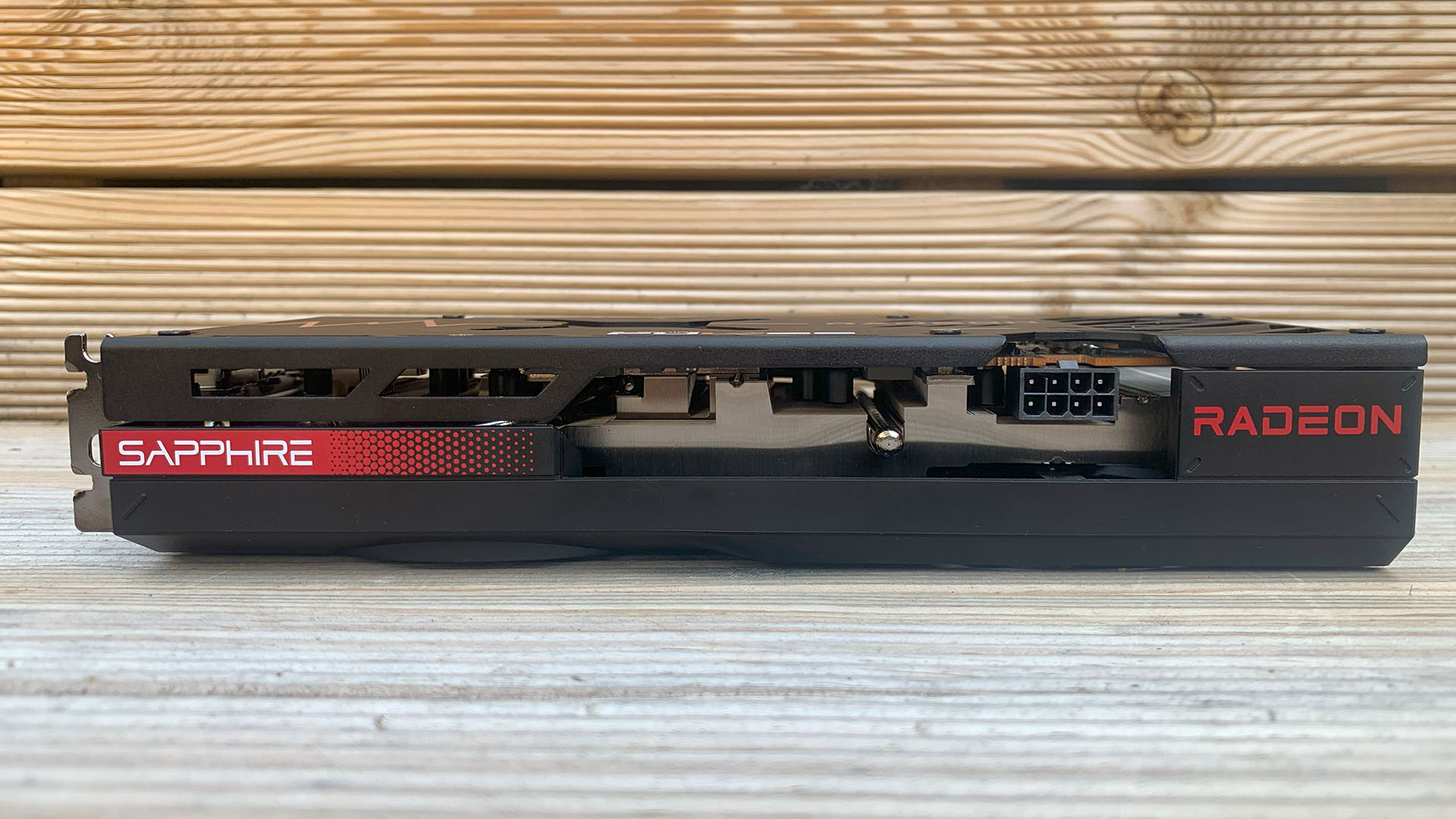
AMD Radeon RX 7600 Assassin’s Creed Valhalla frame rate
The average AMD Radeon RX 7600 Assassin’s Creed Valhalla frame rate is 103fps at 1,920 x 1,080, and 74fps at 2,560 x 1,440.
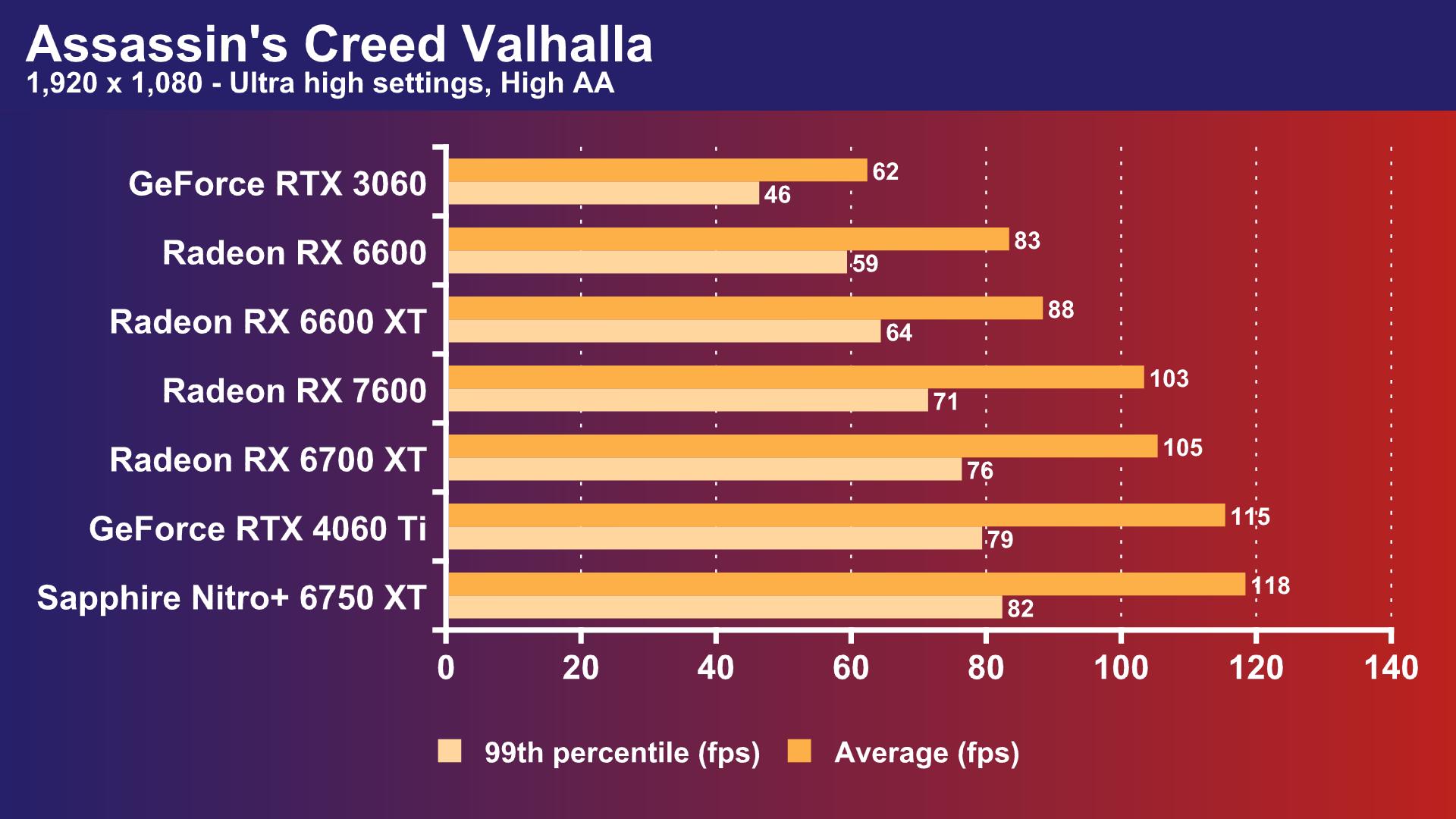
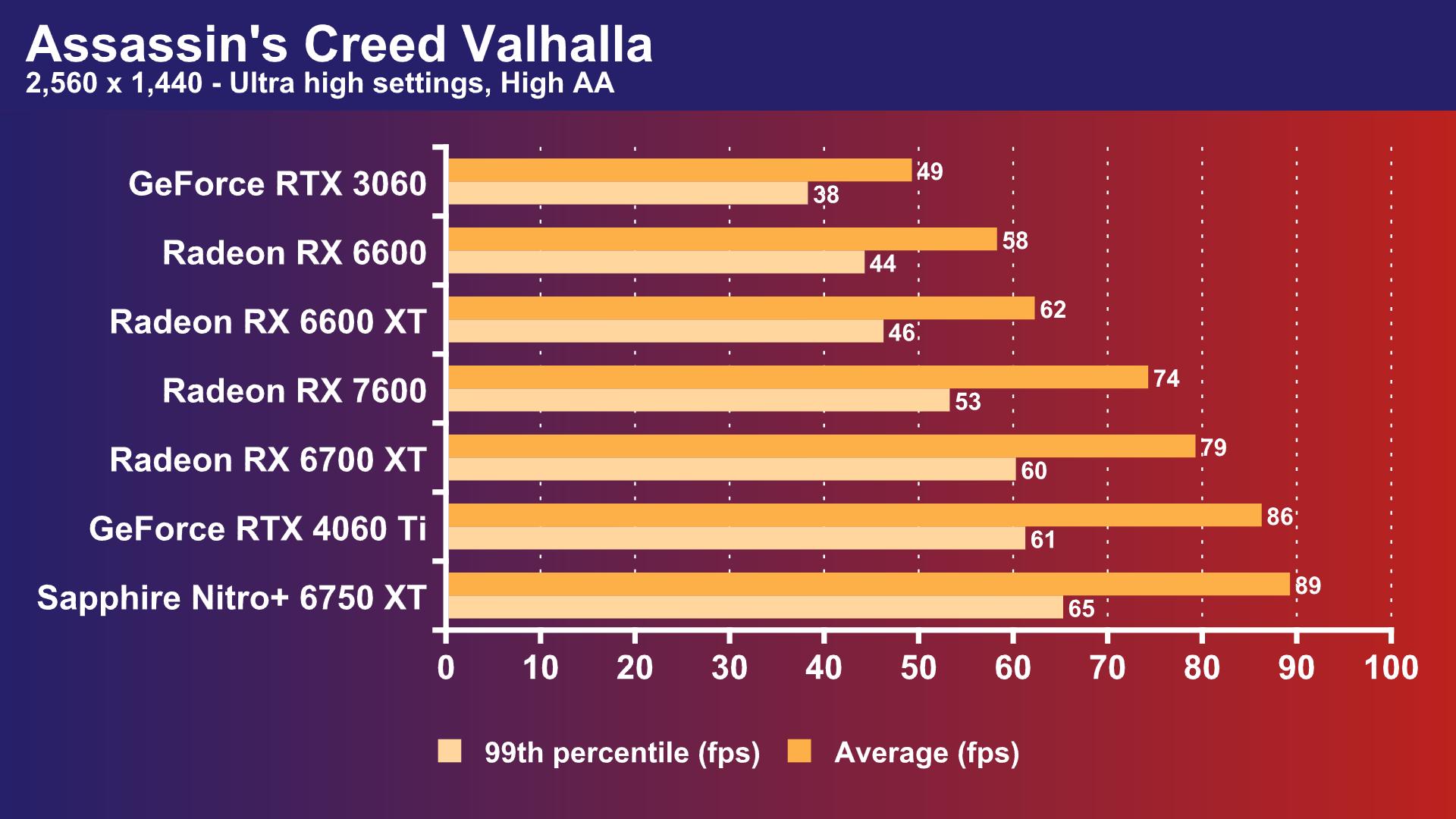
Assassin’s Creed Valhalla has always been a strong title for AMD GPUs, and the Radeon RX 7600 is no different. It’s around 17 percent faster than the Radeon RX 6600 XT at 1080p, and 24 percent faster than the Radeon RX 6600. In fact, its performance is only just behind that of the Radeon RX 6700 XT.
With a 99th percentile frame rate of 53fps at 2,560 x 1,440, you can also happily play this game at top settings beyond 1080p. Comparatively, you only get a 16 percent boost to the average frame rate from the RTX 4060 Ti at this resolution, which is a great result for a card that costs just $269.
AMD Radeon RX 7600 Metro Exodus frame rate
The average AMD Radeon RX 7600 Metro Exodus frame rate is 87fps at 1,920 x 1,080, and 79fps at 2,560 x 1,440.
Without ray tracing, the AMD Radeon RX 7600 copes really well with Metro Exodus. It’s smoothly playable at 1080p, with a 99th percentile result of 51fps, which is higher than the 46fps result we got from the Nvidia GeForce RTX 3060 Ti, and the average is only 1fps behind too.
The 99th percentile drops to 42fps at 2,560 x 1,440, but this is still playable, with an average of 75fps. Even the RTX 4060 Ti only gets a 44fps 99th percentile result in this test, although its 100fps average is a fair bit higher than the 79fps from the Radeon RX 7600.
What’s more, thanks to AMD’s work on improving ray tracing performance with RDNA 3, this game is also playable on the Radeon RX 7600 with High ray tracing enabled. It averaged 65fps with a 99th percentile result of 42fps at 1,920 x 1,080 in this test, which is on par with the Radeon RX 6700 XT and a good way in front of the 47fps and 30fps respective results from the Radeon RX 6600.
That average is also a good 11fps quicker than the Nvidia GeForce RTX 3060, and only 10fps behind the RTX 3060 Ti. RDNA 3 might not have the ray tracing clout of Ada, but it can still cope remarkably well. Running Metro Exodus with ray tracing at 2,560 x 1,440 proved too much for the Radeon RX 7600, however.
AMD Radeon RX 7600 Doom Eternal frame rate
The average AMD Radeon RX 7600 Doom Eternal frame rate is 258fps at 1,920 x 1,080, and 173fps at 2,560 x 1,440.
The AMD Radeon RX 7600 copes really well with Doom Eternal at Ultra Nightmare settings. The 99th percentile result of 154fps at 1,920 x 1,080, and average of 258fps, means you’ll be able to play titles such as this one in sync with a monitor that has a high refresh rate.
Interestingly, this is one test where the older Radeon RX 6600 XT is slightly quicker (albeit only by an average of 2fps), although the Radeon RX 7600 is still well in front of the Radeon RX 6600. The story was similar at 2,560 x 1,440, where the Radeon RX 7600’s average of 173fps is still a great result.
As with the 8GB GeForce RTX 4060 Ti, however, the limited amount of memory stops you from being able to enable ray tracing in Doom Eternal with the Radeon RX 7600. The average frame rate slowed right down to 65fps with a 29fps 99th percentile frame rate.
Bear in mind that while the graphs show that the Radeon RX 7600 is quicker than the RTX 4060 Ti in this test, this is a symptom of the erratic way in which memory affects frame rates when it’s maxed out, and not representative of GPU power – neither result is playable.
AMD Radeon RX 7600 Cyberpunk 2077 frame rate
The average AMD Radeon RX 7600 Cyberpunk 2077 frame rate is 78fps at 1,920 x 1,080, and 47fps at 2,560 x 1,440.
Without ray tracing, the AMD Radeon RX 7600 performance in Cyberpunk 2077 is great. At 1,920 x 1,080 with Ultra settings it averaged 78fps with a 99th percentile result of 64fps at the Ultra preset – that’s on par with the Radeon RX 6700 XT and even quicker than the GeForce RTX 3060 Ti. It’s also a good 32 percent quicker than the Radeon RX 6600 XT.
The Radeon RX 7600 can’t quite cope with this game at 2,560 x 1,440 with Ultra settings, but it’s again substantially quicker than the Radeon RX 6600 XT (and the GeForce RTX 3060 for that matter) – dropping a few settings will enable you to play this game at 2,560 x 1,440, although the GeForce RTX 4060 Ti is much stronger here.
Surprisingly, we were also able to achieve a (just about) playable frame rate in Cyberpunk 2077 at the Medium ray tracing preset on the Radeon RX 7600, but only if we enabled FSR 2.1 on the Balanced setting. It’s unplayable without FSR, hitting an average of 29fps, but this goes all the way up to 52fps (with a 43fps 99th percentile result) with FSR enabled.
This isn’t super-smooth 60fps gameplay, but it’s a top-end game that’s now playable with ray tracing on a $269 card, which is a remarkable result. Of course, if you really want to play this game with ray tracing, the RTX 4060 Ti is much stronger, but it’s good to see that these options aren’t entirely ruled out by using a budget AMD GPU anymore.
AMD Radeon RX 7600 power draw
The AMD Radeon RX 7600 total system power draw is 322W, compared with 309W for the GeForce RTX 4060 Ti.
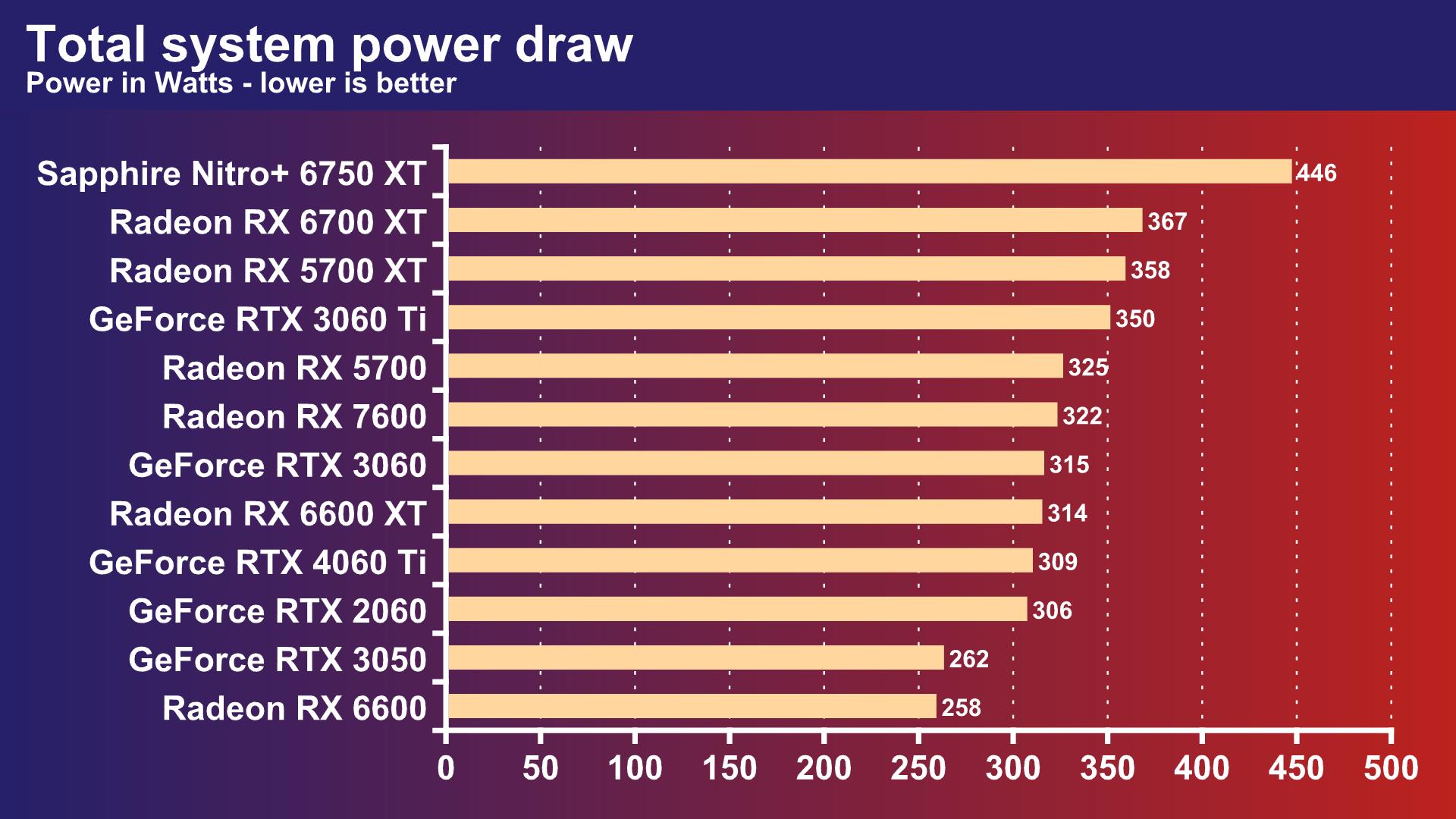
After seeing the stunning power efficiency of the GeForce RTX 4060 Ti, with our system drawing just 309W with this faster card running at full load, we were a little disappointed by the AMD Radeon RX 7600 power draw figures.
Our system drew 322W from the mains with the Radeon RX 7600 installed, which is still a pretty good result, but Nvidia clearly has the upper hand when it comes to performance per Watt at the moment.
AMD Radeon RX 7600 pros and cons
Pros:
- Fantastic price
- Great rasterization performance
- Standard power connector
Cons:
- No AI frame generation tech
- Ray tracing performance could be better
- Only 8GB of VRAM
AMD Radeon RX 7600 specs
The AMD Radeon RX 7600 specs list is:
| GPU | Navi 33 |
| Stream processors | 2,048 |
| RT cores | 32 |
| ROPs | 32 |
| Game clock | 2250 MHz |
| Boost clock | 2660 MHz |
| L2 cache | 2 MB |
| L3 cache (2nd-gen Infinity Cache) | 32 MB |
| Memory | 8 GB GDDR6 |
| Memory bus | 128-bit |
| Memory clock | 2250 MHz (18 GHz effective) |
| Memory bandwidth | 288 GB/s |
| TDP / TGP | 165 W |
| Interface | 8x PCIe 4 |
AMD Radeon RX 7600 price
The price of the AMD Radeon RX 7600 is $269 (£259), which is cheaper than the Radeon RX 6600 launch price.
Price: Expect to pay $269 (£259).
AMD Radeon RX 7600 review conclusion
Well done, AMD. This launch could have gone badly wrong if the Radeon RX 7600 was too expensive, but the price of $269 at a time when there’s no current-gen competition has made this budget GPU a really strong contender.
Crucially, it looks as though AMD has learned that it can’t charge over the odds for a GPU when it can’t compete with Nvidia on ray tracing performance, and when it doesn’t currently have any AI frame-generation tech. The result is a keenly priced 1080p powerhouse that can also handle some gaming at 2,560 x 1,440.
Unlike AMD’s RDNA 2 budget GPUs, ray tracing isn’t off the cards with the Radeon RX 7600 either. It can just about cope at 1,920 x 1,080 in Cyberpunk 2077 with some help from FSR, and it can run Metro Exodus with ray tracing too.
That’s already a big improvement over the Radeon RX 6600 and 6600 XT, but the fact that it costs less than these GPUs at launch is the icing on the cake. The lack of memory rules out ray tracing in games such as Doom Eternal, but you can’t have everything on a GPU at this price.
The Sapphire Pulse AMD Radeon RX 7600 we reviewed also comes thoroughly recommended. This simple, well-made card gives you a decent overclock without a hefty premium, and keeps the noise down without needless frills that push up the price.
The word of warning, of course, is that we know Nvidia will soon come out fighting with the $299 GeForce RTX 4060 in July, which will have the benefit of DLSS 3 support and (probably) stronger ray tracing performance.
Given the Radeon RX 7600’s strong performance elsewhere, though, it still comes highly recommended at the moment. If you’re looking for the best affordable gaming GPU, then go and pick up a Sapphire Pulse AMD Radeon RX 7600 now.
Are you going to bag a bargain AMD Radeon RX 7600 now? Let us know your thoughts and questions on this post by joining the conversation on the Custom PC Facebook page, via Twitter, or join our Custom PC and Gaming Setup Facebook group and tap into the knowledge of our 375,000+ members. You can also find more graphics card recommendations in our best graphics card guide.
